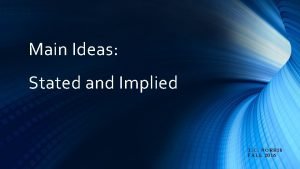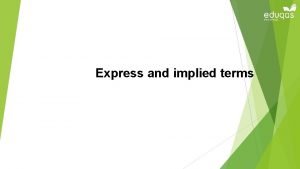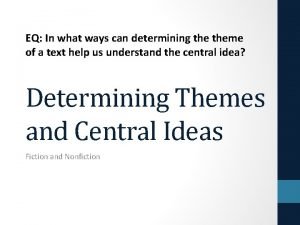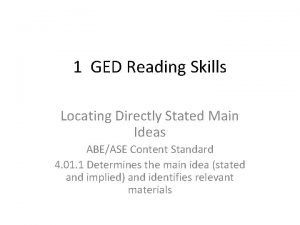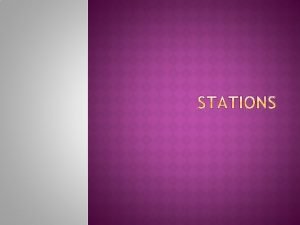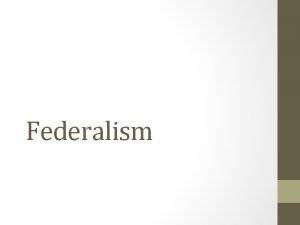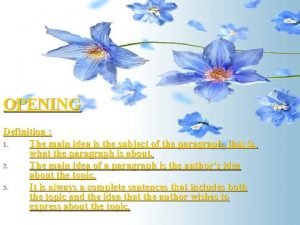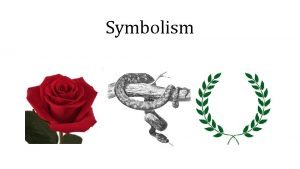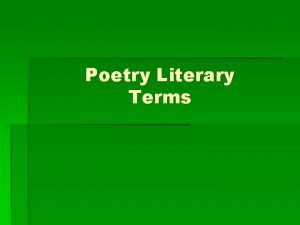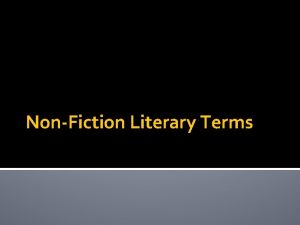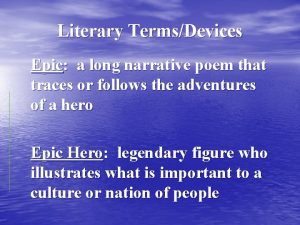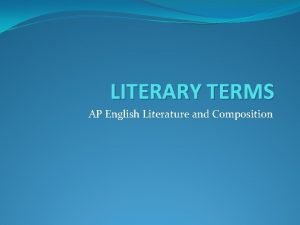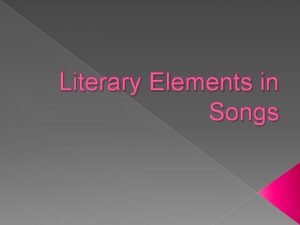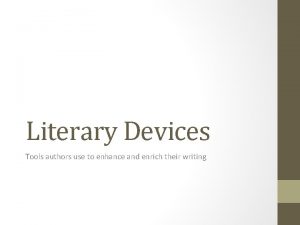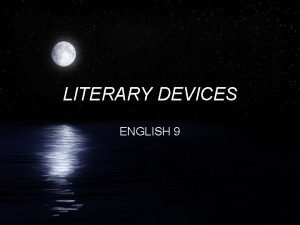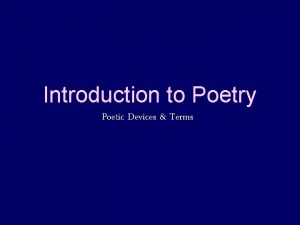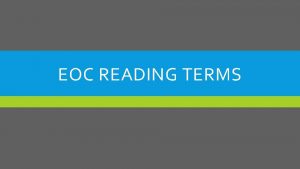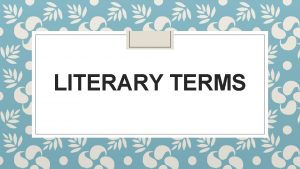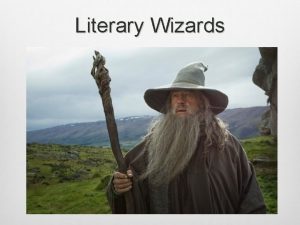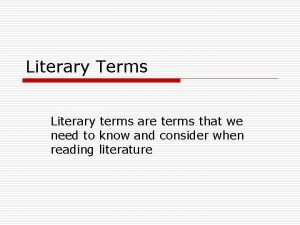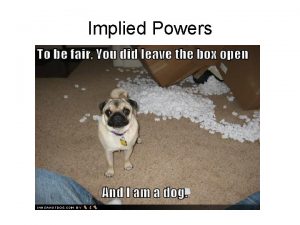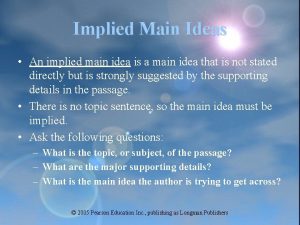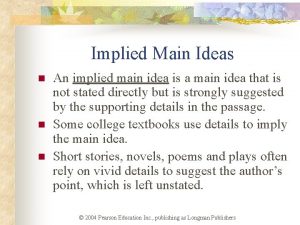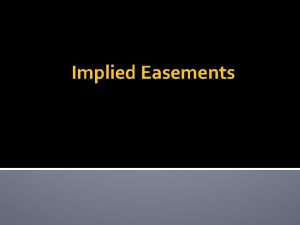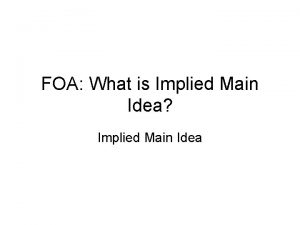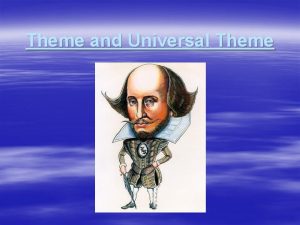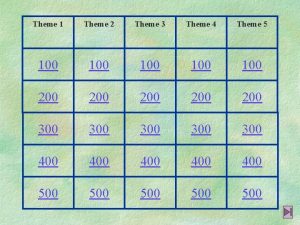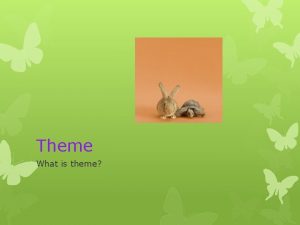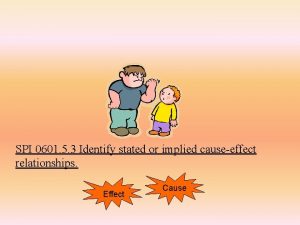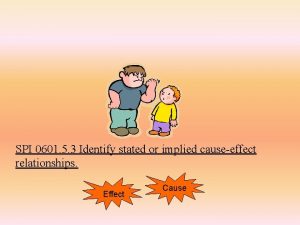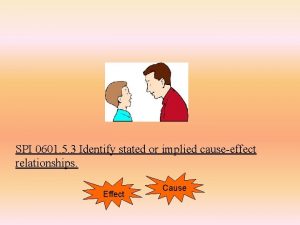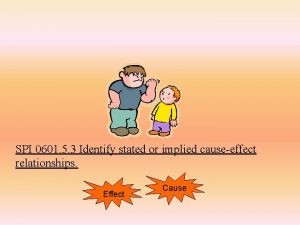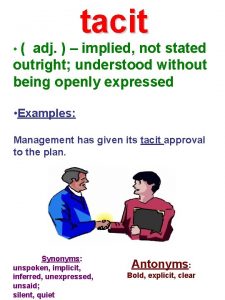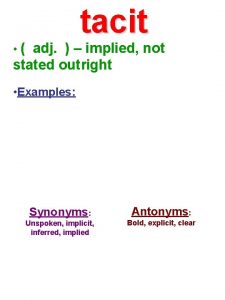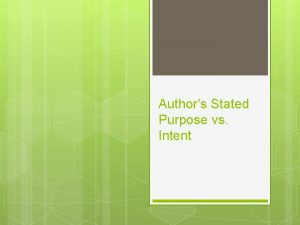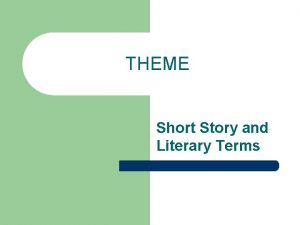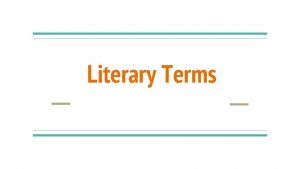Literary Terms Theme Definition The stated or implied


























- Slides: 26

Literary Terms

Theme § Definition: The stated or implied main idea or underlying meaning of a literary work. Theme differs from the subject of a literary work in that it involves a statement or opinion about the topic. § For example, the subject of a story might be war while theme might be the idea that war is useless.

Theme continued § Themes may be major or minor. A major theme is an idea the author returns to time and again. It becomes one of the most important ideas in the story. Minor themes are ideas that may appear from time to time.

Four ways authors demonstrate theme 1. Themes are expressed and emphasized by the way the author makes us feel. By sharing feelings of the main character, you also share the ideas that go through his mind.

Four ways authors demonstrate theme 2. Themes are presented in thoughts and conversations. Authors put words in their character’s mouths only for good reasons. One of these is to develop a story’s themes. The things a person says are much on their mind. Look for thoughts that are repeated throughout the story

Four ways authors demonstrate theme 3. Themes are suggested through the characters. The main character usually illustrates the most important theme of the story. A good way to get at this theme is to ask yourself the question, what does the main character learn in the course of the story?

Four ways authors demonstrate theme 4. The actions or events in the story demonstrate theme. People naturally express ideas and feelings through their actions. One thing authors think about is, “what an action will ‘say? ’" In other words, how will the action demonstrate theme?

Plot § § § Exposition. Rising Action. Climax. Falling Action. Resolution-

Conflict is the essence of fiction. It creates plot. The conflicts we encounter can usually be identified as one of five kinds.

Conflict continued § Person vs. Person Conflict that pits one person against another.

Conflict Continued § Person versus Society The values and customs by which everyone else lives are being challenged. The character may come to an untimely end as a result of his or her own convictions. The character may, on the other hand, bring others around to a sympathetic point of view, or it may be decided that society was right after all.

Conflict Continued § Person versus Nature A run-in with the forces of nature. On the one hand, it expresses the insignificance of a single human life in the cosmic scheme of things. On the other hand, it tests the limits of a person’s strength and will to live.

Conflict Continued § Person versus Self Internal conflict. Not all conflict involves other people. Sometimes people are their own worst enemies. An internal conflict is a good test of a character’s values. Does she give in to temptation or rise above it? Does he demand the most from himself or settle for something less? Does he even bother to struggle? The internal conflicts of a character and how they are resolved are good clues to the character’s inner strength.

Conflict Continued § Person vs. the supernatural: Sometimes, this is grouped in as person v person. However, not always. This is when our main character is battling a non-human force that is another character.

Conflict Continued § Often, more than one kind of conflict is taking place at the same time. In every case, however, the existence of conflict enhances the reader’s understanding of a character and creates the suspense and interest that make you want to continue reading.

Symbolism § Definition: A person, place or object which has a meaning in itself, but suggests other meanings as well. Things, characters and actions can be symbols. Anything that suggests a meaning beyond the obvious. § Some symbols are conventional, generally meaning the same thing to all readers. For example: bright sunshine symbolizes goodness and water is a symbolic cleanser.

What do these symbolize?

Point of View pertains to whom tells the story and the relationship of the narrator to the characters in the story. There are several different ways for a story to be told.

POINT OF VIEW § First Person The narrator is a character in the story who can reveal only personal thoughts and feelings and what he or she sees and is told by other characters. He can’t tell us thoughts of other characters. Anne Frank

Point of View Continued § Third-Person Objective The narrator is an outsider who can report only what he or she sees and hears. This narrator can tell us what is happening, but he can’t tell us the thoughts of the characters.

Point of View Continued § Third-Person Limited. The narrator is an outsider who sees into the mind of one of the characters.

Point of View Continued § Third-Person Omniscient The narrator is an all-knowing outsider who can enter the minds of more than one of the characters—Godlike narrator.

MOTIF § Definition: A recurrent image, word, phrase, represented object or action that tends to unify the literary work or that may be elaborated into a more general theme. Also, a situation, incident, idea, image, or character type that is found in many different literary works, folktales, or myths

ALLUSION § An indirect or passing reference to some event, person, place, or artistic work, the nature and relevance of which is not explained by the writer but relies on the reader’s familiarity with what is mentioned. The technique of allusion is an economical means of calling upon the history or the literary tradition that author and reader are assumed to share.

Allusion illustrated § http: //youtube. com/watch? v=2 h. O 239 D 5 lj s § http: //youtube. com/watch? v=Gf. Ky. M 4 Fgv YA

Connotation/ Denotation § CONNOTATION: The emotional implications and associations that words may carry, as distinguished from their denotative meanings. § DENOTATION: The basic dictionary meaning of a word, as opposed to its connotative meaning
 Stated topic sentence
Stated topic sentence Main idea stated and implied
Main idea stated and implied Difference between express and implied terms
Difference between express and implied terms What is implied theme
What is implied theme What is a implied theme
What is a implied theme Stated main idea definition
Stated main idea definition Define reproduce
Define reproduce Polynomial classification
Polynomial classification Identify like terms
Identify like terms One point perspective
One point perspective Inherent powers examples
Inherent powers examples Definition main idea
Definition main idea Literary terms jeopardy
Literary terms jeopardy Symbolismliterary definition
Symbolismliterary definition Literary definition of symbolism
Literary definition of symbolism Poetry terms hyperbole
Poetry terms hyperbole Nonfiction literary terms
Nonfiction literary terms Literary terms epic
Literary terms epic Ap lit literary terms
Ap lit literary terms A comparison not using like or as
A comparison not using like or as Ano ang tayutay
Ano ang tayutay Symbol rhetorical device
Symbol rhetorical device Metaphor rhetorical device
Metaphor rhetorical device Mood in poem examples
Mood in poem examples Summer diamante poem
Summer diamante poem Eoc literary terms
Eoc literary terms Literary terms of drama
Literary terms of drama
